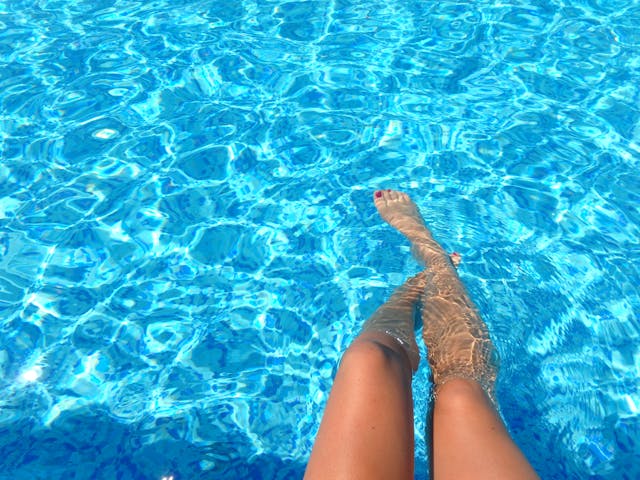In the UK, it is not legally required to have a safety fence around private swimming pools. However, putting a fence around your pool is recommendable for keeping your pool area safe.
Having a fence around your pool should be a necessity rather than a luxury as it means that the pool can be used more safely. A fence is just one element of pool safety. Here we will talk about pool fences, their importance and other ways you can use your swimming pool safely.
Are pool fences legally required in the UK?
No. In the UK there are no laws in place regarding fences around swimming pools, unlike in the US and in Australia. There is no official UK law for swimming pool fences, either for public or private swimming pools. However, swimming pools built in the UK should comply with the Health and Safety at Work Act 1974.
If putting up a fence around your pool, you will not need to apply for planning permission. You will only need to seek planning permission if you want to build a fence of over two metres tall, if you live in a listed property or if your home borders a listed property. However, for a swimming pool there is no need to have a fence that high.
Why put a fence around my pool?
Safety fences around pools can go a long way in preventing any pool-related accidents from occurring. The fence serves as a border for the pool which mitigates the risk of accidental trips or falls. It provides a clear barrier between people and the pool protecting against accidental drownings. A small time and financial investment only, a fence could prevent multiple potential accidents and bring great peace of mind.
Another reason you might want to consider a fence around your pool is to prevent unauthorised access. Having a clear fence around your pool can stop unwanted visitors to the pool. Additionally, the fence can offer privacy and security allowing you to swim in peace without people being able to see you.
What is the cheapest way to put a fence around a pool?
Mesh pool fences often work out as the most affordable choice. They are functional, flexible and one of the cheapest options on the market – cheaper than steel or glass fences.
What is the safest pool fence?
The safest type of pool fence is one that is able to cover all sides of your swimming pool. Fences should be 4-5 feet tall with no gaps and should be non-climbable so that children or others cannot easily climb over. The best materials for a safe pool fence include mesh or aluminium.
How tall does a fence have to be around a swimming pool?
Fences around a swimming pool should be at least 4 feet tall. This is a good minimum height for stopping children climbing over the fence.
What size pool can you have without a fence?
In the UK, you can have a private pool of any size without a fence as there are no legal requirements.
What alternatives are there to pool fences?
Aside from putting a fence up there are other ways you can keep the pool area safe.
Safety covers – safety covers are pulled over the pool when it is not in use. This means that no one is able to fall in the water and accidentally drown. Safety covers are an essential for any pool user. Not only do they protect against drowning, they also ensure that your pool stays clean between uses.
Alarms and motion detectors – motion detectors and alarms can be used to keep people safe by the pool. Motion detectors can set off an alarm if someone is near the pool at an unauthorised time. This can help notify people that there is someone near the pool. For the person near the pool, if they weren’t aware that they were near the pool, they can be alerted to the risk of tripping and falling into the water.
Rescue equipment – equipment such as a life preserver or shepherd’s hook should be kept near the pool at all times. If someone is unable to swim and finds themselves in the pool, the float will help them be able to get to the pool side and to safety.
Best practices for pool safety
Owning a pool can lead to many fun days enjoying the water. However, it also comes with a responsibility for safe usage. For maximum safety, pool fencing should be used in combination with other safety measures.
Safety equipment
There should always be safety equipment easily accessible in any pool. This could prevent a number of potential accidents.
Supervision and swimming training
Anyone using the pool should already know how to swim. When children are using the pool, they should be supervised at all times to minimise the risk of accidents occurring.
Children should also be educated about staying away from pool drains before using the pool. Any drains in the pool should be fitted with anti-entrapment covers to prevent clothes, hair or even limbs being sucked towards them.
Keep the pool area safe
Accidents can also happen outside the pool. The area around the pool can be slippery due to the pool water, making the risk of slipping higher. Anyone using the pool should be extremely careful when walking around the pool. Shoes with grip should be used by everyone to help them keep their balance and avoid falls. Part of this involves keeping the pool area free from hazards – e.g. any floats or toys should always be cleared away so that they’re not left lying around the poolside.
Secure and cover your pool when it is not in use
Your pool should be covered when it is not in use. Not only does this keep the pool clear from debris, dirt and germs which could make the water unhealthy to swim in, it also means that people cannot fall in the water while the pool is not in use.
Ensure pool cleanliness
Proper pool maintenance and regularly cleaning your pool is crucial for safe swimming. Pools that aren’t regularly cleaned can not only look unsightly, due to the buildup of algae, but the dirt and germs can lead to bacteria and infections. Brushing the pool surfaces, cleaning the filters and checking the pool chemical levels regularly is imperative for safe pool usage.


